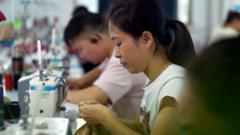In the heart of Guangzhou’s Panyu neighborhood, dubbed the "Shein village," the persistent hum of sewing machines paints a stark picture of the booming fashion industry feeding global consumerism. From dawn till late into the night, workers craft clothing — t-shirts, shorts, swimwear — they know will soon be sold for minimal prices to eager buyers worldwide.
A recent BBC investigation reveals the grueling working conditions that fuel the success of the rapid-fashion brand Shein. During the visit to Panyu, the team interacted with over 20 factory workers, four factory owners, and several textile suppliers, shedding light on a complex web of labor that drives Shein’s massive operations. Workers recounted a staggering typical workload of approximately 75 hours a week, significantly exceeding Chinese labor laws, which mandate a maximum of 44 hours with at least one mandatory day off. For many, the reality includes just one day off per month and relentless production schedules.
Shein, a company valued at an astonishing $66 billion, has drawn both admiration and scrutiny for its aggressive growth and labor practices. While the company claims to be investing considerably in governance and compliance measures, the pressures of demand lead factory owners to cut costs, which often translates to worker exploitation. Workers earn as little as one yuan (less than $0.15) per t-shirt and hustle to piece together a meager income, sometimes sending earnings home to support families in rural areas.
Labor markets in Panyu are teeming with hopeful job seekers eyeing positions in Shein's factories, creating scenes of intense competition among workers. Echoing their struggle for higher wages, many expressed the impossible balance between rising living costs and their paltry earnings. Human rights advocates highlight this exploitation as emblematic of broader issues in fast fashion, with workers grappling against systemic inequalities in the industry.
Meanwhile, Shein’s algorithms analyze consumer behavior online to dictate production, ensuring rapid turnover of trendy items. However, these profits come at the cost of worker welfare, with reports surfacing of sweatshop-style conditions, particularly in the wake of allegations surrounding sourcing practices linked to forced labor in regions like Xinjiang. While Shein works to bolster its public image ahead of a potential IPO, the broader conversation about its ethical responsibilities continues to grow.
As night descends and the city quiets, Shein’s factories remain aglow, illustrating a resilient workforce eager to secure economic stability amidst precarious conditions. For many, working in Shein’s supply chain is viewed as an integral contribution to the global fashion landscape, though the human cost remains a subject of profound concern.



















